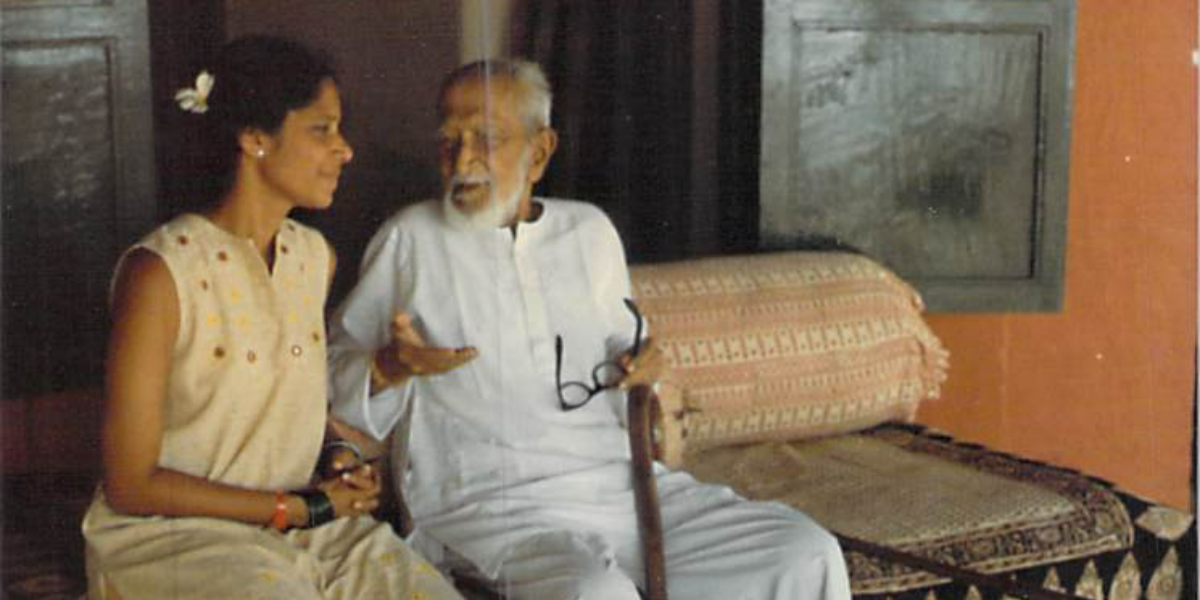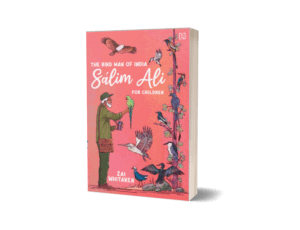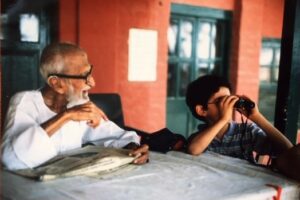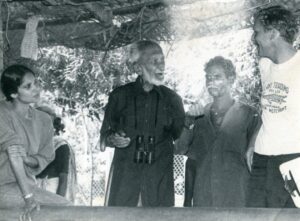Naturalist Zai Whitaker's new book explores the life and times of her granduncle, Salim Ali, and his love for birds.

Salim Ali educating Zai Whitaker about birds. (Supplied)
Born into a family of naturalists, Zai Whitaker thinks she is a “bad birder”. “I often have to ask others for help with identification (of birds),” she confesses.
And yet, her latest book is based on these feathered friends and the man who made many discoveries about them. Titled, Salim Ali for Children: The Bird Man of India, the book is published by Hachette India and is an ode to Indian ornithologist Salim Ali.
“This book was first published by Permanent Black in 2003 with the title Salim Ali for Schools,” shares Whitaker, a Mumbai native. “When the print was sold out and Permanent Black wasn’t able to do another edition, writer and teacher friends encouraged me to find another publisher and luckily, Hachette took it on,” she reveals.

Salim Ali for Children The Bird Man of India, the book is published by Hachette India and is an ode to Indian ornithologist Salim Ali. (Supplied)
The latest book, however, has many new additions and changes to bring up-to-date information about birds to readers. Whitaker is Ali’s grand-niece, who has seen the ornithologist’s work up, close and personal.
“Salim mamoo was a meticulous scientist, disciplined observer and note-taker, and had the patience of a saint…with birds, not with noisy nieces and nephews,” she laughs.
“He was also a ‘crack shot’, important in the pre-DNA days when identification and taxonomy depended on stuffed specimens.”
Whitaker’s father, Zafar Futehally, also an ornithologist and the founder of the Newsletter for Birdwatchers, often accompanied Ali on bird surveys and bird-banding camps. But growing up, Whitaker enjoyed picnics more than birdwatching itself.
“As a child, birdwatching was followed by picnics, and were very enjoyable; often near streams where paper boats could be sailed and we could get drenched,” she remembers.
Young Whitaker resented birds. “Because my school friends would get together on weekends to go to the movies, or listen to the American rock band “The Doors” at home. But in our family, it was understood that one only did “outdoors”,” she recalls.
While Whitaker grew up in Mumbai, she moved to Chennai after college and marriage when she was 20.
“I had moved from a bird-centric family to a reptile-centric one, and threw myself into the work there,” she recalls of her time at the reptile conservation centre.
Currently, Whitaker stays near the Madras Crocodile Bank that she helped get started in Mahabalipuram in 1976.
“Today we have 15 of the world’s 23 species of crocodiles, and a total of some 40 species of reptiles, including several endangered ones,” says Whitaker, who has also worked at the Madras Snake Park.
She even taught in Kodaikanal for 18 years, and has written over 20 books on environmental issues. These include Andamans Boy, Salim Mamoo and Me, Kali and the Rat Snake, and Cobra in My Kitchen.
“Because now, more than ever before, our children need good role models in the area of conservation and he is certainly one of these.”
Ali died in 1987 but his legacy lives on through the incredible work he has left behind and through Whitaker’s books celebrating his life.
Salim Ali for Children: The Bird Man of India begins with a chapter on Ali’s observations of a sparrow.
Growing up with his uncle and aunt, Ali was taken to Chembur (a suburb of Mumbai), a forested area then, for the summer holidays. Sparrows were in abundance back then.
Today, you barely spot one in the city.

Ali died in 1987 but his legacy lives on through the incredible work he
has left behind and through Whitaker’s books celebrating his life. (Dilbar Combernous)
If he were alive today, what would Ali think of this dwindling population of sparrows, we ask.
“When mamoo died, the worst of our forest decimation was yet to come, but the process had started,” Whitaker explains.
“He was dismayed and frustrated by it and appealed to Indira Gandhi to stop the madness of the Silent Valley hydel project in Kerala (and succeeded). The decrease in Mumbai’s birds and the upsurge in the numbers of crows would have upset him. Crows, as he used to point out, destroy the eggs and fledglings of other birds; and the heaps of garbage we provide them with, has caused a population explosion.”
“Birds and insects for instance, could survive happily without us, but not vice versa. But apart from the survival aspect, nature adds such richness to our lives: visually, aurally, psychologically. Let it into your life, spend time watching birds and trees, and your life will become so much more full, and fun.”

Zai’s husband Rom Whitaker, Zai and a colleague with Salim Ali during one of his visits to the Crocodile Bank. (Supplied)
Among the many discoveries Ali made about birds as a naturalist, Whitaker’s favourite is the one about weaver birds.
“The males woo females by working hard to make beautiful nests the females would like, and wait anxiously for one that will approve, and agree to be his mate,” she smiles.
Whitaker’s book has some visually-rich illustrations created by Rohan Dahotre.
Of his works, Whitaker says: “He has caught the spirit of the incidents, and tone of the book, so well; as well as the spirit of the birds! The cover is startling and practically unforgettable, and Salim mamoo on the back cover, on his motorbike, is simply wonderful. Among the inside illustrations, my favourite is little Salim at the Bombay Natural History Society…an incident often discussed with him, at family get-togethers.”

Apr 30, 2024

Apr 30, 2024

Apr 30, 2024

Apr 30, 2024

Apr 30, 2024

Apr 29, 2024